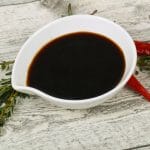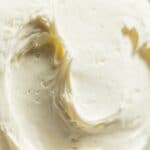In summary: Balsamic vinegar can be substituted with Soy Sauce, Red Wine Vinegar and Maple Syrup, and Red Wine Vinegar, Worcestershire Sauce, Maple Syrup, and Lemon Juice, etc. Consider the specific taste you want to achieve when selecting the best substitute.
The complex sweet flavor of balsamic vinegar is what makes it distinctly different from most other vinegar that is predominantly acidic in taste. The Italian vinegar’s dark color and thick consistency also make it a unique condiment.
If your recipe calls specifically for balsamic and you don’t have any on hand, we’ve lined up the best substitutes for balsamic vinegar you can use in a pinch for the same flavor boost.
What is Balsamic Vinegar?
Traditional balsamic is made from the juice of fresh white grapes (with skins and seeds) which are boiled and reduced down. The reduction has a high sugar concentration which is slowly fermented in wooden barrels over 12 years (or longer) and aged to intensify the flavor.
Stored in these wooden casks, it becomes sweet, concentrated, and thickens as a portion evaporates.
Commercial-grade products, however, don’t undergo the same process as traditional Italian vinegar. Although made with a small percentage of grape must, they generally contain additions of wine vinegar, caramel, coloring, and thickeners to mimic the traditional product.
This versatile ingredient is used largely in savory dishes but also has many sweet applications. It can be used as a condiment or dipping sauce or added to cooked recipes.
You are probably most familiar with it in salad dressing or drizzling on bread or vegetables but it is also great as a marinade for meat, poultry, or as a pork glaze. In desserts, it works well as a fruit glaze with honey.
Regardless of which dish you’re making if you don’t have any of this deep-flavored punchy sauce on hand, here’s what you can use as a substitute for balsamic vinegar.
Best Balsamic Vinegar Substitutes
Since balsamic has both a sweet and acidic profile, many alternative options will include a blend of ingredients to attain the right flavor balance.
To get the best results, use a whisk to mix ingredients together well or shake them up in a glass jar. If you are making a larger batch, you can combine it in a blender. Once mixed, let the mixture sit for a couple of minutes before stirring and using.
Here’s what to use in place of balsamic vinegar:
1. Soy Sauce, Grape Jelly, and Red Wine Vinegar
Considering that balsamic is made from unfermented grape juice, the sweetness from the grape jelly and acidity from the red wine vinegar are very apt choices here, making it our best substitute option.
The soy sauce brings a depth of color and complexity of flavor to the mix while the grape jelly offers a little thickness for a similar consistency.
Substitute quantity: To replace 2 tablespoons of balsamic, combine 2 tablespoons of red wine vinegar, 1 teaspoon of grape jelly, and only ½ a teaspoon of soy sauce.
Best for: Vegetable and meat marinades, glazes, dipping sauce, and savory salad dressings.
2. Red Wine Vinegar and Maple Syrup
These are two ingredients you may already have in the pantry. Together the combination brings both the sweet and acidic characteristics required to make a delicious balsamic vinegar substitute.
It is preferable to use real maple syrup as opposed to the manufactured or artificial type.
Substitute quantity: To replace two tablespoons, combine 2 tablespoons of red wine vinegar and 2 teaspoons of maple syrup well.
Best for: Dipping condiments and sweet or savory dressings and sauces. It can also be combined with other ingredients for glazes and marinades.
3. Worcestershire Sauce, Maple Syrup, and Lemon Juice
If you don’t have red wine vinegar but have Worcestershire sauce, try this combo instead.
The Worcestershire sauce brings a unique complexity of flavor and will also give you a similar dark color. It is the perfect ingredient to pair with meat, add to stews, and make marinades.
Lemon will bring balance and acidity while maple will add the missing sweetness.
Substitute quantity: To replace two tablespoons, combine 2 tablespoons of Worcestershire sauce with 2 to 3 teaspoons of maple depending on the level of sweetness preferred. Squeeze in a dash of lemon.
Best for: Meat and veggie marinades, poultry dishes, dressings, dipping sauces, stews, and glazes.
4. Soy Sauce, Molasses, and Lemon Juice
If you don’t have maple or don’t want the flavor of maple in your dressing or sauce, molasses can be used as a sweetening agent instead.
Molasses has a rich flavor and thick consistency which is ideal for marinades and dipping sauces. The soy sauce brings depth and will give you the same dark coloring.
Substitute quantity: Mix equal quantities of soy sauce, molasses, and lemon or lime juice to make your balsamic vinegar replacement. Adjust to taste if necessary and replace the mixture in equal measures.
Best for: Marinades, glazes, meat, poultry, pork, or vegetable dishes, dipping sauces, and stews.
5. Balsamic Vinaigrette
These vinaigrettes generally include balsamic, and olive oil (or another vegetable oil), and some also have spices or herbs, flavoring agents, and thickeners or preservatives.
Regardless of the added ingredients, they have a pronounced balsamic vinegar taste so will make a good substitute when you don’t have plain balsamic on hand. Due to the additional seasonings, this won’t be suitable for sweet dishes but can be used in almost any savory application.
Substitute quantity: Use the vinaigrette in equal quantities.
Best for: Salads, dipping sauces, drizzled over vegetables or egg dishes, and marinades.
6. Apple Cider Vinegar and Sugar
Apple cider vinegar has a potent acidic quality which needs to be balanced out with granulated sugar. It is commonly used as a base in salad dressings and has a light yellow color.
Granulated white sugar works best to balance the acidity, however, brown sugar can give a slightly richer color. When combining the ingredients make sure the sugar is completely dissolved before using it in your dish.
If you want a thicker syrupy consistency, heat the mixture over low heat while stirring until the sugar dissolves completely.
Substitute quantity: Mix two parts apple cider vinegar with one part sugar. For example, combine two tablespoons of vinegar with one tablespoon of sugar. Use this combo as a replacement measure for measure.
Best for: Salad dressings and when combined with other ingredients it can also be used in pork and meat glazes.
7. Fruit Vinegar Blends
Similar to the above option, other fruits are also used to make vinegar. If you have any fruit vinegar at home you can combine these with some honey or brown sugar to make a replacement.
Some of these varieties may already have some sweetness so make sure to taste it before adding it to the rest of your ingredients.
Substitute quantity: Mix two parts vinegar with one part honey or brown sugar. Replace the mixture in equal quantities.
Best for: Fruit vinegar combined with brown sugar is best for salad dressings while mixing it with honey makes a great glaze for veggies, meat, pork, and fish.
8. White Wine Vinegar and Sugar
This combination is more delicate and does not have the same punch or color. However, it won’t steer the flavors of your dish in a different direction and still offers the base acid and sweet elements you’re looking for.
Substitute quantity: Mix two parts vinegar with one part sugar. Replace the mixture in equal quantities.
Best for: Salad dressings, and fish or vegetable marinades. It is not suitable as a rich glaze or marinade for heavier meat.
9. Sherry Vinegar
This option can be used on its own, without any added ingredients. Although it doesn’t have the same color and has a thinner consistency, it has similar sweet and acid flavors.
Substitute quantity: Use this alternative in equal amounts.
Best for: Dressings or mixed with other ingredients to make marinades, sauces, and glazes.
10. Lemon Juice, Lime Juice, and Sugar
In a simple dressing, this can bring the acid and sweet notes you are missing although the color, depth, and consistency will be different.
This requires some testing to perfect the sweet and acid levels according to your preference but that’s the great thing about making your own mix – you can tailor it to your preferences.
Substitute quantity: Mix equal parts lemon juice, lime juice, and sugar until the sugar is fully dissolved. Tweak with extra lemon if you need a more tangy taste. Replace the mixture measure for measure
Best for: Dressings and added to other ingredients in a marinade.
FAQs
Conclusion
As with any replacement, it is important to pick a balsamic vinegar alternative that works best for the specific dish you are making. In this case, light vinegar with a sweetener works best for dressings while soy or Worcestershire blends provide the deep color and richness required for glazes and marinades.
Keep the color, taste, texture, or consistency in mind when choosing your substitute. Most of all, take the freedom to tailor it to exactly the level of sweetness and acidity you prefer. Bon appetit!
See more: White wine vinegar alternative
*image by chalkova/depositphotos









